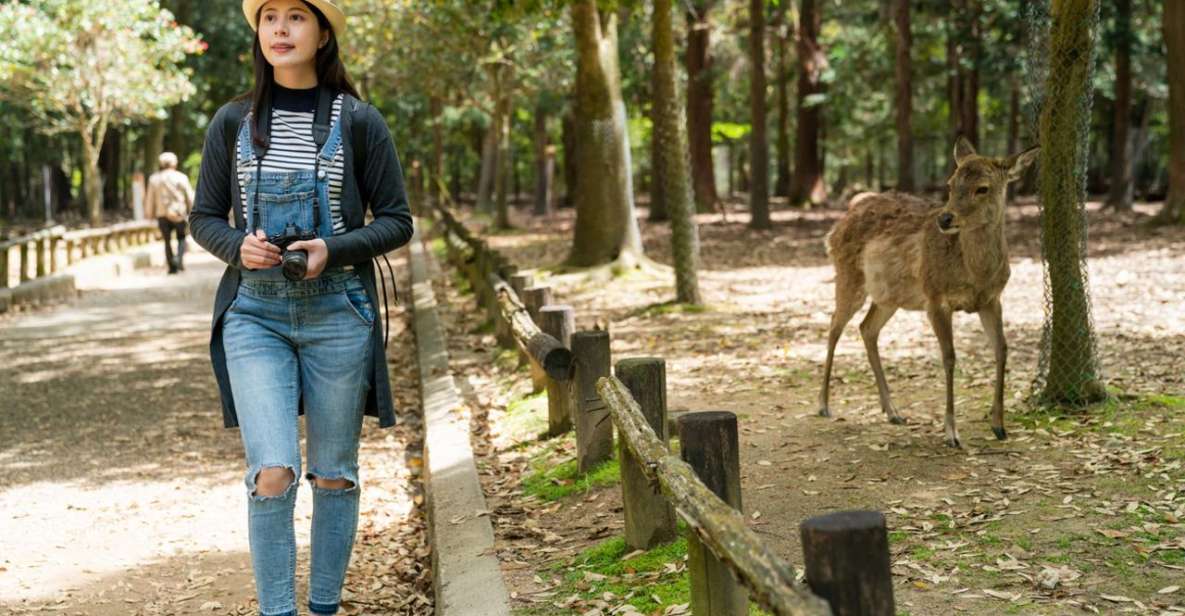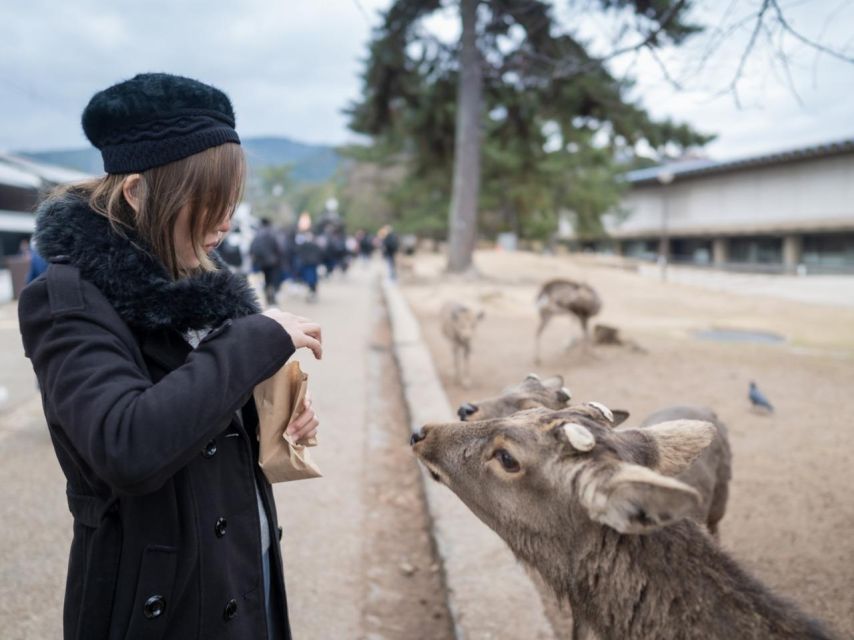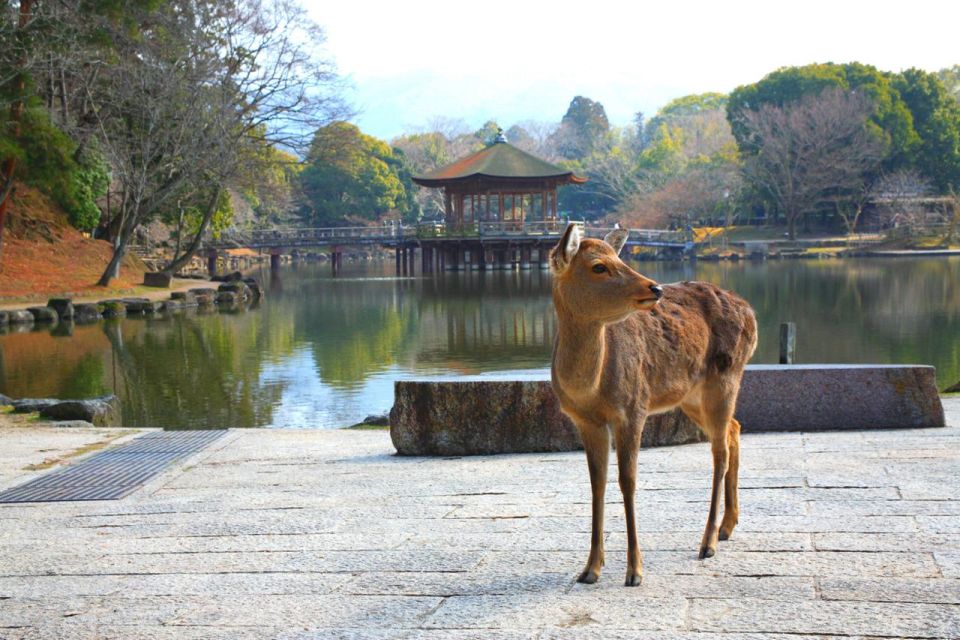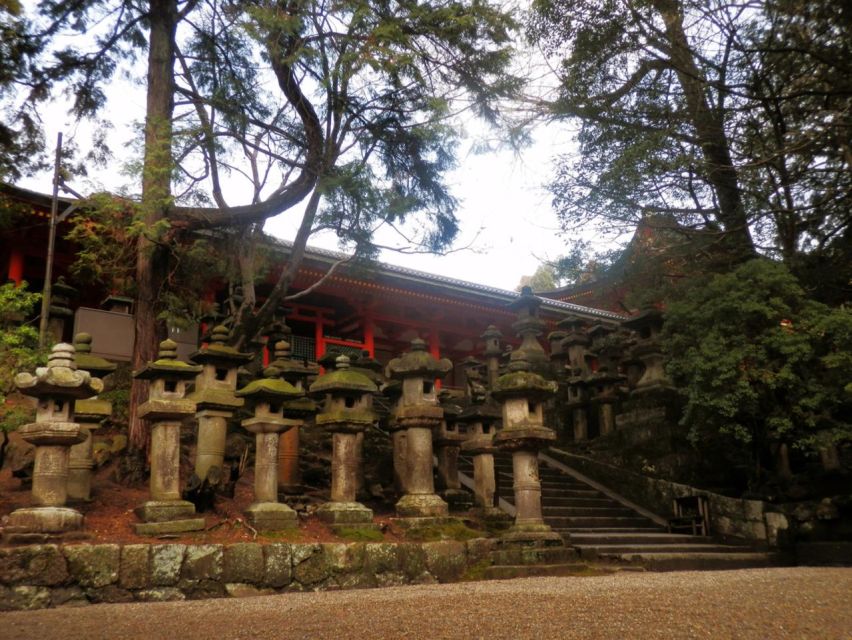Nara’s historical wonders beckon travellers on a captivating journey through time and nature. From the colossal bronze Buddha of Todaiji Temple to the serene deer roaming Nara Park, the city’s spiritual legacy is palpable. Centuries-old lanterns at Kasuga Taisha Shrine and the UNESCO-listed Horyuji Temple offer a window into Nara’s enduring cultural heritage. Exploring the well-preserved Naramachi District and the Buddhist temples, national museum, and ancient palace site creates an immersive experience, revealing the fascinating interplay of history, spirituality, and natural beauty that defines this captivating Japanese city. There’s so much more to discover about Nara’s treasures.
This experience made our list of the 8 Best Historical Tours In Nara.
Key Points

-
Todaiji Temple’s colossal bronze Buddha statue, the largest of its kind, showcases Nara’s rich Buddhist heritage and captivates visitors.
-
Nara Park’s tranquil deer, considered sacred in Japanese culture, offer a serene sanctuary for visitors to observe and interact with the gentle creatures.
-
Kasuga Taisha Shrine’s thousands of centuries-old bronze and stone lanterns create a serene and ethereal ambiance, reflecting Nara’s spiritual traditions.
-
Horyuji Temple, a UNESCO World Heritage site, boasts some of the world’s oldest wooden structures, including a serene statue of the Shaka Nyorai Buddha.
-
The Naramachi District’s well-preserved machiya townhouses and artisanal shops invite visitors to enjoy Nara’s historic architecture and cultural legacy.
Todaiji Temple: Colossal Buddha

Towering over the lush greenery of Nara Park, the Todaiji Temple proudly displays its awe-inspiring centerpiece – a colossal bronze Buddha statue, the largest of its kind in the world.
Measuring an impressive 15 meters in height, the Great Buddha’s serene expression and intricate detailing captivate visitors from around the globe.
Surrounded by ornate halls and shrines, the temple complex offers a window into Nara’s rich Buddhist heritage.
As you gaze upon the majestic figure, you can’t help but feel a sense of wonder and reverence for this architectural and spiritual masterpiece that has stood the test of time for over 1,300 years.
You can also read our reviews of more historical tours in Nara
Nara Park’s Tranquil Deer

Just steps away from the towering Todaiji Temple, Nara Park offers a serene sanctuary where deer roam freely amidst the tranquil greenery.
These gentle creatures, considered sacred in Japanese culture, captivate visitors with their curious nature and approachable demeanor.
Visitors can:
- Feed the deer with special deer crackers, available for purchase at nearby stands.
- Observe the deer as they lazily lounge under the shade of ancient trees or wander the picturesque pathways.
- Capture stunning photos of the deer against the backdrop of historic temples and shrines.
Exploring Nara Park’s deer-filled landscapes allows travelers to enjoy the peaceful harmony between nature and Japan’s rich cultural heritage.
Kasuga Taisha Shrine’s Lanterns

Among the many captivating sights within the historic Nara region, the Kasuga Taisha Shrine stands out for its mesmerizing display of thousands of centuries-old bronze and stone lanterns.
Lining the pathways and adorning the shrine’s structures, these traditional Japanese lanterns create a serene and ethereal ambiance, inviting visitors to enjoy the timeless elegance of Nara’s spiritual heritage.
The lanterns, some of which date back centuries, cast a warm, flickering glow that seems to emanate from the very heart of the shrine.
As visitors wander through the tranquil grounds, they’re enveloped in the soft light, feeling a profound connection to the rich cultural traditions that have been preserved here for generations.
Horyuji Temple’s UNESCO Heritage
Although often overshadowed by the grandeur of Todaiji’s Great Buddha, Horyuji Temple’s UNESCO-listed heritage holds a profound significance, standing as one of the world’s oldest wooden structures and a testament to Japan’s enduring cultural traditions.
This 7th-century Buddhist complex boasts several key highlights:
The Yumedono, or ‘Hall of Dreams,’ which houses a serene statue of the Shaka Nyorai Buddha.
The stunning five-story pagoda, one of the oldest wooden structures in the world, its elegant silhouette a symbol of Nara’s architectural mastery.
The Kondo, or Golden Hall, with its intricate murals and Buddhist sculptures, offering a glimpse into the artistry that flourished during Horyuji’s golden age.
Visitors to Nara are sure to be captivated by the timeless beauty and significance of this UNESCO World Heritage Site.
More Great Tours NearbyNaramachi District’s Historic Streets

The historic streets of Naramachi District transport visitors on an enchanting journey through Nara’s storied past, where centuries-old architecture and timeless traditions converge to create a captivating cultural tapestry. Meandering through the narrow alleyways, one is struck by the well-preserved machiya townhouses, their wooden facades and intricate latticed windows offering glimpses into a bygone era. Artisanal shops, traditional crafts, and quaint cafes line the streets, inviting explorers to enjoy the district’s rich heritage. From historic merchant homes to revered shrines, each step unveils new layers of Nara’s enduring legacy, making Naramachi a must-visit destination for any traveler seeking to connect with the heart and soul of this captivating city.
| Highlights | Description | Significance |
|---|---|---|
| Machiya Townhouses | Preserved merchant homes with wooden facades and latticed windows | Showcase traditional Nara architecture and daily life |
| Artisanal Shops | Stores offering locally-made crafts, textiles, and culinary delights | Celebrate the region’s rich artisanal heritage |
| Shrines and Temples | Revered religious sites dotting the historic district | Reflect Nara’s enduring spiritual and cultural legacy |
| Narrow Alleyways | Winding pathways that invite visitors to meander and discover | Capture the intimate, time-honored atmosphere of the district |
| Quaint Cafes | Cozy establishments serving traditional Japanese fare and refreshments | Provide opportunities to pause, reflect, and take in local culture |
Nara’s Buddhist Heritage Sites

Throughout Nara’s historic landscape, an array of revered Buddhist heritage sites stand as testaments to the region’s profound spiritual legacy, each one a captivating destination for travelers seeking to enjoy the enduring traditions that have shaped this captivating city.
Among the must-see highlights are:
-
Kofukuji Temple, a stunning complex that boasts the second-tallest pagoda in Japan and is renowned for its exquisite architecture and impressive collection of Buddhist art.
-
Yakushiji Temple, a UNESCO World Heritage site renowned for its beautiful gardens and well-preserved structures that date back to the 7th century.
-
Shinyakushiji Temple, a tranquil sanctuary that showcases the region’s rich Buddhist heritage through its intricate carvings, stunning sculptures, and serene atmosphere.
Nara National Museum’s Exhibits

Nestled within Nara’s historic landscape, the Nara National Museum stands as a testament to the region’s rich cultural heritage, housing an impressive collection of artifacts that offer visitors a captivating glimpse into the enduring traditions and artistic achievements that have defined this captivating city.
From ancient Buddhist sculptures to exquisite calligraphic works, the museum’s galleries showcase the exceptional craftsmanship and spiritual influence that have permeated Nara’s legacy.
Guests can enjoy interactive exhibits, exploring the intricate details of ceremonial robes, delicate porcelain, and enigmatic relics that illuminate the spiritual and artistic evolution of this remarkable destination.
Whether seeking deeper understanding or simply appreciating the beauty of Japan’s cultural treasures, the Nara National Museum provides a truly enlightening experience.
Heijo Palace Site’s Remnants
Amidst Nara’s captivating historical landscape, the Heijo Palace Site stands as a testament to the grandeur and significance of Japan’s ancient imperial legacy. Though only remnants of the once-majestic complex remain, visitors can still glimpse the architectural splendor and strategic importance that defined this seat of power during the Nara period.
The site offers a glimpse into the past through three key features:
- The palace foundations, which showcase the sheer scale of the original structure.
- The archaeological excavations, revealing intricate details about the layout and design of the imperial residence.
- The serene gardens and parks, which evoke a sense of the tranquility that once pervaded the imperial grounds.
Exploring the Heijo Palace Site is a captivating journey back in time, allowing visitors to connect with Nara’s profound historical significance.
Frequently Asked Questions

What Is the Best Time of Year to Visit Nara?
The best time to visit Nara is during the spring or fall when the weather’s mild and the natural scenery is stunning. Crowds are smaller, allowing for a more peaceful exploration of the historic sites and deer-filled parks.
Are There Any Discounts or Packages Available for the Tour?
The tour offers group discounts, with prices starting at £686.70 for up to 4 people. Customers can also take advantage of the flexible booking policy, with free cancellation up to 24 hours in advance.
Can the Itinerary Be Customized to Suit Individual Preferences?
The tour operator offers flexible customization options, allowing travelers to tailor the itinerary to their individual interests and preferences. They’ll work closely with guests to curate an experience that best suits their needs and travel goals.
Are There Any Special Events or Festivals in Nara During the Tour?
The tour may coincide with special events or festivals in Nara, such as the Nara Lantern Festival held annually in February, where the historic shrines and temples are illuminated by thousands of lanterns. Guests can inquire about upcoming events during booking.
What Is the Average Group Size for the Nara Historical Tour?
The Nara historical tour accommodates groups of up to 4 people, offering a personalized experience to explore the region’s renowned temples, shrines, and natural wonders at your own pace.
Recap
Nara’s historical wonders captivate visitors with their timeless elegance. From the awe-inspiring Todaiji Temple to the tranquil deer of Nara Park, the city’s spiritual legacy and natural beauty intertwine seamlessly.
Kasuga Taisha Shrine’s lanterns, Horyuji Temple’s UNESCO heritage, and the preserved Naramachi District offer a window into Nara’s enduring cultural heritage.
This remarkable city invites travelers to embark on a journey through time and nature, seeing Japan’s rich history and the harmonious coexistence of the sacred and the natural.
You can check availability for your dates here:More Historical Tours in Nara
- Private 3-Hour UNESCO Heritage Sites & Deer Park Tour
- Full Day Nara E Bike Tour and Osaka History Food Tour
- Nara: 1.5 Hour Private Kasuga Taisha Shrine Tour – World Heritage
- Nara World Heritage PRIVATE TOUR
- World Heritage Kyoto & Nara Uji Authentic Matcha Experience
- Private Journey in Nara’s Historical Wonder
More Tour Reviews in Nara
- Full Day Nara Deer, Temple, Shrine, Activities & Tea Ceremony
- Private 3-Hour UNESCO Heritage Sites & Deer Park Tour
- 2-Hour Nara: Discover Every Bit of Tohdaiji-Temple Private Tour
- Full Day Nara E Bike Tour and Osaka History Food Tour
- Nara: 1.5 Hour Private Kasuga Taisha Shrine Tour – World Heritage
- Interactive Geisha Experience in Nara
Not for you? Here's more nearby things to do in Nara we have reviewed
- Full Day Nara Deer, Temple, Shrine, Activities & Tea Ceremony
- Private 3-Hour UNESCO Heritage Sites & Deer Park Tour
- 2-Hour Nara: Discover Every Bit of Tohdaiji-Temple Private Tour
- Full Day Nara E Bike Tour and Osaka History Food Tour
- Nara: 1.5 Hour Private Kasuga Taisha Shrine Tour – World Heritage
- Interactive Geisha Experience in Nara
- Guided Tour of Todai-ji and Nara Park (Guide in Spanish)
- Perfect Nara Park Half-Day Bus Tour With English Speaking Guide
- Nara: Half-Day Private Tour of 4 Must-See Spots & Deer Park
- Nara Half Day Walking Tour
- 1 Day Walking Tour in Nara Palace Deer and Inkstick
- Nara World Heritage PRIVATE TOUR
